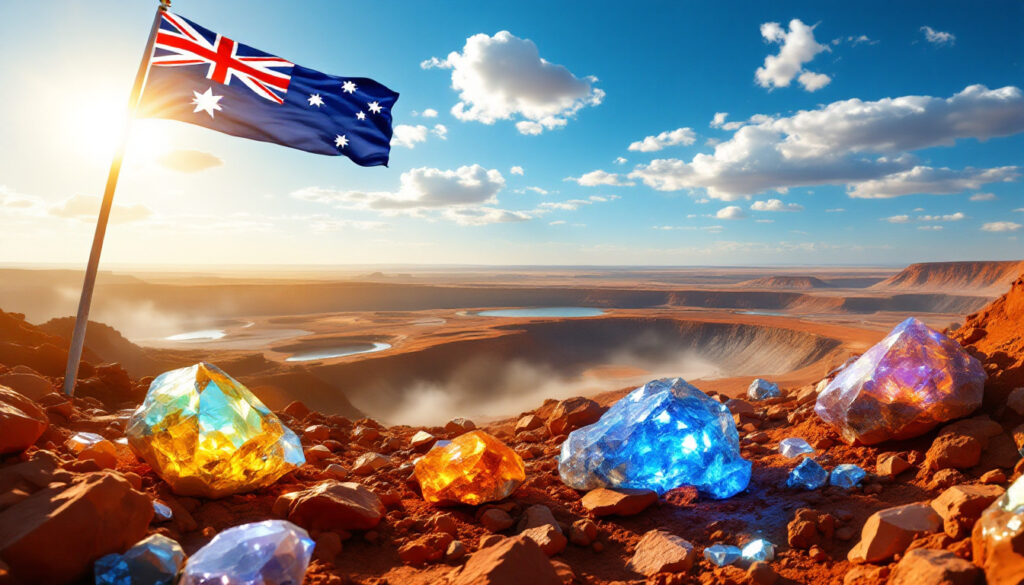What is Australia's Critical Minerals Stockpile Plan?
Australia's Critical Minerals Stockpile Plan is a $1.2 billion government initiative designed to bolster the nation's resilience against global supply chain disruptions. The plan includes a $1 billion expansion of the existing Critical Minerals Facility, enabling direct purchases of minerals from commercial projects to create a strategic reserve. This reserve will serve dual purposes: supplying domestic industries and fulfilling commitments to international partners, particularly in sectors like clean energy and defense. The program's implementation is contingent on the re-election of the Labor government, with specific timelines yet to be finalized.
Funding Structure and Strategic Objectives
The $1.2 billion allocation comprises $1 billion for the Critical Minerals Facility and $200 million for initial mineral acquisitions. By acting as a guaranteed buyer, the government aims to stabilize prices and provide market confidence for mining projects struggling with financing. This approach mirrors strategies employed by nations like Japan, which has secured long-term contracts with Australian miners to ensure resource access.
Why is Australia Creating a Critical Minerals Stockpile?
Geopolitical Tensions and Supply Chain Security
The plan responds to escalating trade tensions between China and Western nations. China's recent export restrictions on critical mineral shortages, retaliating against U.S. tariffs under the Trump administration, have exposed vulnerabilities in global supply chains. Australia, holding the world's largest lithium reserves and significant nickel and cobalt deposits, seeks to leverage its resource wealth to establish an independent supply network. Prime Minister Albanese emphasized that the stockpile would allow Australia to "deal with trade disruptions from a position of strength."
Economic and Strategic Benefits
Beyond geopolitical considerations, the stockpile offers economic advantages. Australian exporters may gain exemption from the U.S.'s 10% tariff on critical minerals, enhancing competitiveness. Additionally, the guaranteed government market could attract investment into mining projects, particularly for junior explorers facing capital shortages. Shadow Minister for Resources Susan McDonald has advocated expanding the critical minerals list to include copper, uranium, and alumina, reflecting broader industry demands.
How Will the $1.2 Billion Critical Minerals Reserve Work?
Implementation Strategy
The government will prioritize minerals essential for renewable energy technologies, such as lithium for batteries and rare earth elements like dysprosium for permanent magnets. State-level approval processes, however, remain a hurdle. Trigg Mining Managing Director Andre Booyzen criticized "long and onerous" environmental assessments, arguing that bureaucratic delays could undermine the plan's effectiveness.
Market Mechanisms and International Partnerships
Stockpiled minerals will be available to both domestic manufacturers and allied nations, though pricing mechanisms remain undefined. Australian Strategic Materials CEO Rowena Smith highlighted the need for parallel investments in downstream processing, noting that raw material stockpiles alone cannot secure end-to-end supply chains.
What Do Industry Experts Say About the Plan?
Association of Mining and Exploration Companies (AMEC)
AMEC CEO Warren Pearce praised the plan's alignment with the Critical Minerals Production Tax Incentive (CMPTI), stating it would "help projects secure financing." He urged policymakers to expand the list of eligible minerals to include by-products like zircon and titanium, which are critical for aerospace applications.
Minerals Council of Australia (MCA) Concerns
MCA CEO Tania Constable questioned the stockpile's economic logic, warning of "downward pressure on commodity prices." Instead, she advocated for the Junior Minerals Exploration Incentive, which could stimulate $725 million in greenfields exploration over a decade. Constable also emphasized reducing energy costs and accelerating approval timelines to improve sector competitiveness.
How Do Mining Companies View the Stockpile Plan?
Positive Reception from Project Developers
VHM Limited CEO Ron Douglas linked the stockpile to "Western governments' support" for his company's Goschen rare earths project, which recently secured a mining license. The project's dual revenue streams—heavy minerals and rare earths—exemplify the diversified operations the government aims to promote. Similarly, Australian Strategic Materials' Dubbo project, producing niobium and rare earths, is positioned to contribute to the stockpile while advancing downstream processing capabilities.
Cautionary Voices on Market Dynamics
Red Metal Managing Director Rob Rutherford warned that excessive stockpiling could create a "market overhang," suppressing prices during demand downturns. He proposed federal co-investment in overseas magnet manufacturing facilities to secure offtake agreements for Australian rare earth oxides.
What Minerals Should Be Included in the Stockpile?
Current Critical Minerals Focus
While lithium, nickel, and cobalt are explicitly prioritized, industry stakeholders have advocated for broader inclusion. Shadow Minister McDonald's proposal to add copper, uranium, and potash aligns with U.S. and EU critical mineral lists, enhancing alignment with ally needs. Antimony, facing global shortages due to depleted Chinese reserves, has also emerged as a contender, though its inclusion remains uncertain.
Proposed Additions
The debate around which minerals deserve "critical" designation continues to evolve. The Coalition government has proposed expanding the stockpile to include copper, uranium, zinc, bauxite, alumina, aluminum, potash, phosphate and tin – reflecting a broader approach to supply chain security. Industry experts have also emphasized the importance of including rare earth by-products that are essential for advanced manufacturing.
What Challenges Face the Critical Minerals Stockpile Plan?
Bureaucratic and Market Hurdles
State-level environmental approvals, often taking years to complete, could delay stockpile acquisition. Trigg Mining's Booyzen noted that "no amount of funding" would offset inefficient regulatory processes. Additionally, the plan's reliance on Labor's re-election introduces political uncertainty, with alternative proposals from the Coalition focusing on exploration incentives rather than stockpiling.
Price Volatility and Supply Chain Gaps
MCA's Constable highlighted the risk of government stockpiles distorting market signals, potentially discouraging private-sector investment. Without complementary investments in refining and manufacturing, Australia risks remaining a raw material exporter rather than a value-added producer.
How Does the Stockpile Plan Compare to Alternative Approaches?
U.S. and European Approaches
The U.S. Defense Production Act prioritizes domestic processing and manufacturing subsidies, while the European Critical Raw Materials Act emphasizes recycling and diversification. Australia's critical minerals stockpile plan diverges by focusing on upstream resource security, though experts argue for integrating elements of both models to build midstream capabilities.
Asian Contract-Based Strategies
Japan and South Korea's reliance on long-term offtake agreements with Australian miners offers a market-driven alternative. These contracts provide price stability without requiring government inventory management, though they lack the strategic flexibility of a physical reserve. Furthermore, understanding global critical minerals strategies is essential for contextualizing Australia's approach within international frameworks.
Geological and Quality Considerations for Stockpiled Minerals
Mineral Grade Impact on Stockpile Strategy
The grade and quality of minerals significantly influence their strategic value for stockpiling. Australia's mining sector trends show that lithium deposits are predominantly high-grade spodumene, making them more cost-effective to process than lower-grade sources. This geological advantage enhances the economic viability of the stockpile plan, particularly when considering long-term storage requirements.
Processing Requirements and Technical Specifications
Critical minerals require different processing technologies depending on their geological composition. The stockpile plan must account for these variations, potentially including provisions for preliminary processing to ensure stored minerals remain viable for future use. Expert metallurgists have noted that certain rare earth elements can degrade if stored improperly, necessitating specialized storage protocols.
FAQ: Australia's Critical Minerals Stockpile Plan
When will the stockpile be operational?
Implementation depends on the Labor government's re-election, with acquisitions likely commencing in late 2025. According to the Australian government's minerals policy, the timeline will be structured to prioritize minerals facing immediate supply constraints.
Which minerals are guaranteed inclusion?
Lithium, nickel, and cobalt are prioritized, though antimony and rare earths may be added pending further consultations.
How will the stockpile affect mining companies?
Guaranteed offtake agreements could improve project bankability, but oversupply risks may deter investors during price downturns. Comprehensive mining feasibility insights are essential for companies evaluating participation in the program.
Will global prices be impacted?
Economists caution that large-scale government purchases could suppress prices, particularly if global demand weakens.
How does the critical minerals stockpile plan address processing capabilities?
While the plan primarily focuses on raw materials acquisition, industry experts emphasize the need for parallel investments in refining and manufacturing capacity to maximize economic benefits.
What safeguards exist to prevent market distortion?
The government has not yet detailed specific market intervention thresholds or price mechanisms, raising concerns about potential market distortions if implementation lacks transparency. Investors should consider geopolitical investor strategies when navigating this evolving landscape.
Want to Identify the Next Major Mineral Discovery Before the Market?
Discovery Alert's proprietary Discovery IQ model instantly notifies investors about significant ASX mineral discoveries, turning complex data into actionable insights for both short-term traders and long-term investors. Explore how major discoveries create substantial returns by visiting Discovery Alert's dedicated discoveries page.




